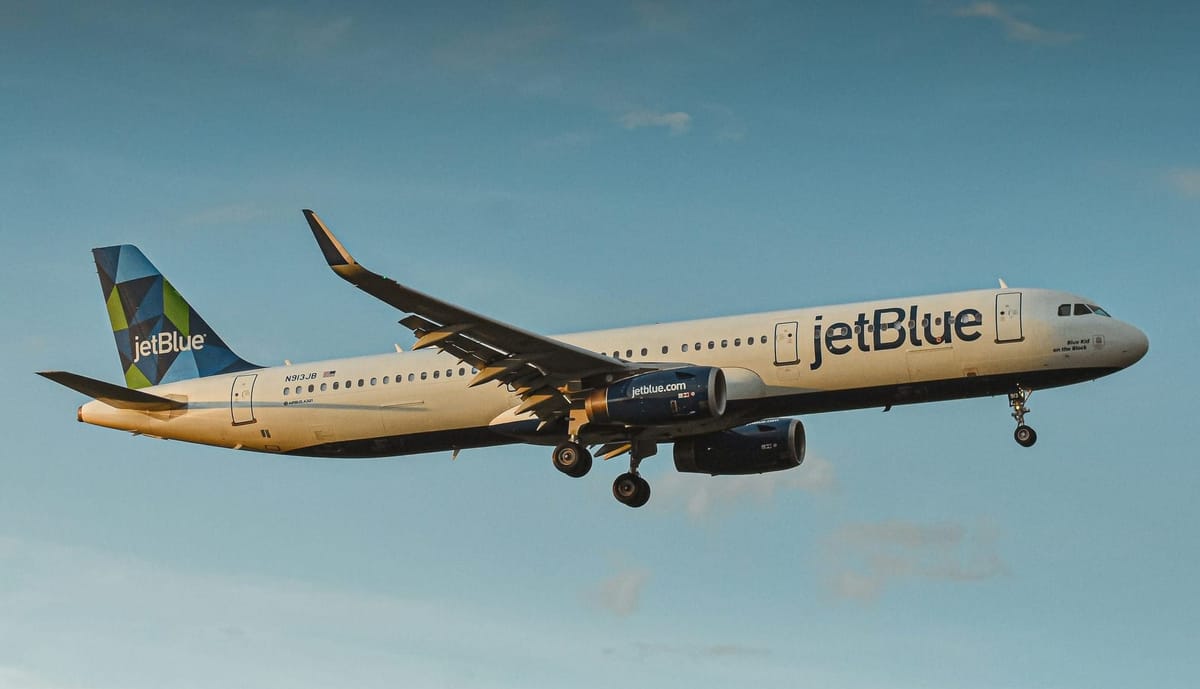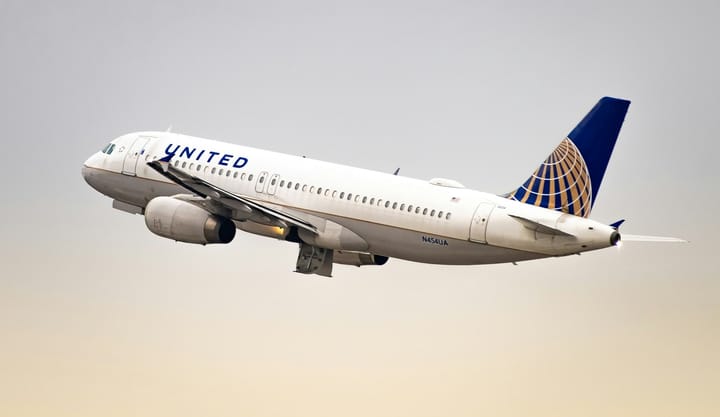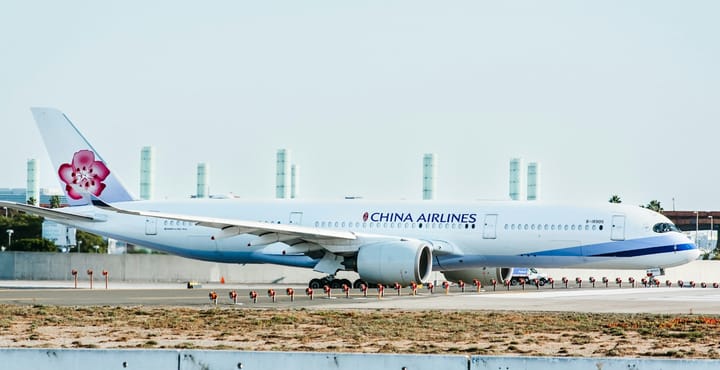Analyzing JetBlue Airways' operational and financial performance, with a focus on its customer-centric approach, expansion of international routes, Mint premium service, sustainability efforts, and key metrics like ASM, RPM, and financial stability through revenue and net income insights.
1. Total Passengers Carried
JetBlue Airways, established in 2000, has evolved into a significant player in the U.S. aviation industry, emphasizing a customer-centric approach. The airline's network includes 105 destinations across 28 states, the District of Columbia, Puerto Rico, the U.S. Virgin Islands, and 31 countries in the Caribbean, Latin America, Canada, and Europe. This expansive reach reflects JetBlue's commitment to connecting diverse markets and catering to a broad passenger base.
In recent years, JetBlue has undertaken strategic initiatives to optimize its route network, focusing on high-performing leisure and visiting-friends-and-relatives (VFR) markets. During 2024, the airline redeployed approximately 20% of its network, closing 15 stations and exiting over 50 routes. This realignment aimed to enhance profitability and operational efficiency by concentrating on core geographies such as New York, New England, Florida, and Puerto Rico.
JetBlue's commitment to customer satisfaction has been recognized through various awards. In 2023, the airline received the Editors’ Choice Award for Best Economy Class across U.S. airlines from “The Points Guy” for the fourth time. Additionally, JetBlue launched a new TrueBlue® loyalty program, offering enhanced perks and options, which has generated exceptional growth and engagement, particularly from Mosaic customers.
Operational performance has been a focal point for JetBlue. In 2024, the airline achieved a system-wide on-time performance of 74.1%, an improvement from 67.4% in 2023. The completion factor also increased to 98.6% in 2024 compared to 98.1% in 2023, indicating enhanced reliability in flight operations.
JetBlue's financial strategies have included significant cost-saving measures. The airline's structural cost program achieved $190 million in total program savings, setting the foundation for continued cost control through its JetForward initiative. Furthermore, JetBlue deferred approximately $3 billion of capital expenditures and raised over $3 billion of strategic financing in 2024, strengthening its financial position.
2. Total Flights Operated
JetBlue's flight operations are predominantly point-to-point, with 96% of routes touching at least one of its six focus cities: New York, Boston, Fort Lauderdale-Hollywood, Orlando, Los Angeles, and San Juan. This network structure allows the airline to efficiently manage its flight operations and cater to various market demands.
Despite these improvements, JetBlue faced challenges with flight delays, leading to a $2 million fine imposed by the U.S. Department of Transportation in 2025 for chronic delays on certain East Coast routes. The airline attributed these delays to outdated air traffic control systems and has called for modernization to address systemic issues contributing to delays.
Looking ahead, JetBlue plans to introduce domestic first-class cabins on all non-Mint® aircraft beginning in 2026, enhancing its service offerings. The airline also announced plans for the opening of airport lounges at JFK Terminal 5 and Boston Logan Terminal C, expected to open in late 2025 and shortly thereafter, respectively. These initiatives aim to attract premium travelers and enhance the overall customer experience.
3. Available Seat Miles (ASM)
JetBlue Airways' Available Seat Miles (ASM), a critical metric for assessing airline capacity, experienced a 3.5% year-over-year decline in 2024, totaling 66.1 billion ASMs compared to 68.5 billion in 2023. This reduction reflects the airline's strategic decision to optimize its network by exiting underperforming routes and focusing on core markets. In the fourth quarter alone, ASMs decreased by 5.1% year-over-year, indicating a concerted effort to align capacity with demand and improve operational efficiency.
The ASM contraction is part of JetBlue's broader JetForward initiative, aimed at enhancing profitability through disciplined capacity management. By reallocating resources to high-performing leisure and visiting-friends-and-relatives (VFR) markets, the airline seeks to maximize revenue per available seat mile (RASM). This approach involves a meticulous analysis of market dynamics to ensure that capacity deployment aligns with passenger demand patterns.
JetBlue's fleet strategy also plays a pivotal role in ASM management. In 2024, the airline deferred approximately $3 billion in capital expenditures, including aircraft deliveries, to better match capacity growth with market conditions. This prudent approach allows JetBlue to maintain financial flexibility while positioning itself to capitalize on future demand surges.
Operational metrics further underscore the effectiveness of JetBlue's capacity management. The airline achieved a load factor of 83.2% in 2024, up from 82.6% in 2023, indicating improved utilization of available seating capacity. This enhancement suggests that the airline's capacity adjustments have successfully balanced supply with passenger demand, leading to more efficient operations.
Looking ahead, JetBlue projects flat ASM growth for the full year 2025, reflecting a cautious approach amid evolving market dynamics. The airline's focus on optimizing its network and maintaining operational discipline positions it to respond agilely to demand fluctuations, ensuring sustainable growth and profitability.
4. Revenue Passenger Miles (RPM)
Revenue Passenger Miles (RPM), representing the total miles flown by paying passengers, declined by 3.16% year-over-year in 2024, totaling ∼55 billion RPMs compared to ∼56.7 billion in 2023. This decrease aligns with the airline's strategic capacity reductions and network optimization efforts aimed at enhancing overall profitability.
Despite the RPM decline, JetBlue's load factor improved to 83.2% in 2024, up from 82.6% in 2023, indicating more efficient utilization of available seating capacity. This improvement suggests that the airline's focus on high-demand routes and markets has effectively balanced passenger traffic with available capacity, leading to enhanced operational efficiency.
JetBlue's yield per passenger mile, a measure of revenue generated per mile flown by a paying passenger, was reported at 15.68 cents in 2024, down from 15.92 cents in 2023. This slight decrease reflects competitive pricing pressures and changes in the airline's route mix, emphasizing the importance of strategic revenue management in maintaining profitability.
The airline's revenue management strategies, including the introduction of new fare options and enhancements to its loyalty program, aim to stimulate demand and increase RPMs. By offering tailored products and services, JetBlue seeks to attract a broader customer base and encourage repeat business, thereby boosting passenger traffic and revenue.
In 2025, JetBlue anticipates a modest increase in RPMs, supported by its continued focus on network optimization and customer-centric initiatives. The airline's strategic investments in product offerings and operational efficiency are expected to drive passenger demand and enhance revenue performance, contributing to its long-term growth objectives.
5. Passenger Load Factor (%) Analysis
JetBlue Airways reported a system-wide passenger load factor (PLF) of 83.2% for the full year 2024, marking a 0.6 percentage point improvement over 2023. This uptick indicates enhanced efficiency in matching capacity with demand, despite a 2.9% year-over-year decline in Revenue Passenger Miles (RPMs) and a 3.5% reduction in Available Seat Miles (ASMs). The airline's strategic focus on high-demand routes and capacity optimization contributed to this improved load factor, reflecting a disciplined approach to network planning.
Quarterly analysis reveals variability in PLF, with the third quarter of 2024 achieving a peak of 86.6%, driven by strong summer travel demand. Conversely, the fourth quarter saw a decline to 82.2%, influenced by seasonal factors and operational challenges, including the grounding of aircraft due to Pratt & Whitney engine issues. These fluctuations underscore the importance of agile capacity management and the ability to adapt to external disruptions.
JetBlue's PLF performance also reflects its efforts to enhance revenue quality through initiatives like the JetForward program. By focusing on premium offerings, loyalty programs, and international expansion, the airline aims to attract higher-yield passengers, thereby improving load factors and overall profitability. Continued investment in customer experience and network optimization is expected to sustain and potentially enhance PLF in the coming years.
6. Financial Performance Analysis
6.1. Operating Revenue ($) Performance
JetBlue's operating revenue trajectory in 2024 demonstrated resilience amid industry challenges. The airline's quarterly revenues were as follows: Q1 - $2.209 billion, Q2 - $2.428 billion, Q3 - $2.365 billion, and Q4 - $2.277 billion. The second quarter marked the highest revenue, benefiting from peak travel demand and strategic capacity deployment.
The airline's revenue performance was bolstered by its focus on high-demand markets and the introduction of new services. JetBlue's commitment to enhancing the customer experience, including the expansion of its Mint premium service and loyalty programs, played a significant role in attracting and retaining passengers, thereby driving revenue growth.
6.2. Net Income ($) Analysis
The airline faced challenges in the first quarter of 2025, reporting a net loss of $208 million. This loss was influenced by a 3.1% year-over-year decrease in operating revenue and a 4.3% reduction in system capacity. JetBlue's proactive measures, including cost optimization and strategic adjustments, are aimed at mitigating these challenges and returning to profitability in subsequent quarters.
JetBlue Airways' 2024 financial performance reflects a strategic recalibration amid industry headwinds. The airline reported a net loss of $795 million, impacted by a 3.5% decline in operating revenue to $9.28 billion and increased special items related to merger termination and union negotiations. Despite these challenges, the JetForward initiative contributed $90 million to EBIT, with $395 million in revenue initiatives exceeding targets by $95 million. Operationally, JetBlue improved its passenger load factor to 83.2% and enhanced on-time performance by six points year-over-year, indicating progress in aligning capacity with demand and improving customer experience.




Comments ()